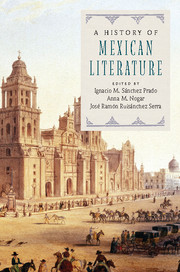Book contents
- Frontmatter
- Contents
- List of contributors
- Introduction
- PART I COLONIAL LITERATURE
- PART II THE NINETEENTH CENTURY
- PART III TWENTIETH AND TWENTY-FIRST CENTURIES
- 15 The Ateneo de la Juventud: The Foundations of Mexican Intellectual Culture
- 16 Regimes of the Avant-garde: Colonialists, Stridentists, Proletarians, Surrealists, Contemporáneos, and Independent Rupture (1920–1950)
- 17 The Institution of Fiction: From Yáñez, Rulfo, and Fuentes to Pitol and Del Paso
- 18 Octavio Paz: Literature, Modernity, Institutions
- 19 Mexican Poetry after the Avant-garde
- 20 Nonfictions: Essay, Criticism, and Chronicle
- 21 Balancing Acts: Twentieth- and Twenty-First-Century Mexican Theater
- 22 Women Writers in the Land of “Virile” Literature
- 23 The Hidden Histories of Gender: LGBTQ Writers and Subjectivities in Mexico
- 24 Mexican Literature in the Neoliberal Era
- PART IV MEXICAN LITERATURE BEYOND BOUNDARIES
- Index
- References
20 - Nonfictions: Essay, Criticism, and Chronicle
from PART III - TWENTIETH AND TWENTY-FIRST CENTURIES
Published online by Cambridge University Press: 05 July 2016
- Frontmatter
- Contents
- List of contributors
- Introduction
- PART I COLONIAL LITERATURE
- PART II THE NINETEENTH CENTURY
- PART III TWENTIETH AND TWENTY-FIRST CENTURIES
- 15 The Ateneo de la Juventud: The Foundations of Mexican Intellectual Culture
- 16 Regimes of the Avant-garde: Colonialists, Stridentists, Proletarians, Surrealists, Contemporáneos, and Independent Rupture (1920–1950)
- 17 The Institution of Fiction: From Yáñez, Rulfo, and Fuentes to Pitol and Del Paso
- 18 Octavio Paz: Literature, Modernity, Institutions
- 19 Mexican Poetry after the Avant-garde
- 20 Nonfictions: Essay, Criticism, and Chronicle
- 21 Balancing Acts: Twentieth- and Twenty-First-Century Mexican Theater
- 22 Women Writers in the Land of “Virile” Literature
- 23 The Hidden Histories of Gender: LGBTQ Writers and Subjectivities in Mexico
- 24 Mexican Literature in the Neoliberal Era
- PART IV MEXICAN LITERATURE BEYOND BOUNDARIES
- Index
- References
Summary
Twentieth-century Mexican literary authors produced a rich and varied corpus of writings that may be grouped together within the broad category of nonfiction discourse. The essay, literary and cultural criticism, and the chronicle served as vehicles for documenting events and exploring urgent questions of national identity, Mexico's political life and social conflicts, and high culture and popular art within changing conditions in a highly diverse society. Documentary or nonfiction writing practices such as the chronicle, while generally less studied in literary histories, often attract a large readership and give rise to debates over the meanings that they assign to events, public figures, personal experiences, and cultural phenomena. The capacity of nonfiction to create controversy and excite debate is rooted in the quality of overt referentiality that distinguishes it from works of fiction, with which it otherwise shares many formal and thematic features. Nonfiction owes a particular debt to what we call “real life” or “the real world,” the extratextual referent to which the work points. Although the referent of real-life events is always already mediated by language and convention and is not raw material to be reproduced in the text, nonfiction is assumed to bear a measure of responsibility for the accuracy of its account of human actions that works of fiction may evade. Mexican writers have long relied on the distinctive qualities of nonfiction to record, commemorate, critique, and protest against verifiable events and social conditions in an attempt to shape the national discourse around pressing issues of Mexico's past and present (Jörgensen, 2011: 191–197).
Essay
This chapter is organized into three sections that treat the essay, works of literary and cultural criticism, and the crónica, in that order. Liliana Weinberg, a foremost scholar of the Latin American essay, offers this basic definition of the genre: a carefully crafted prose composition that manifests the author's well-founded, responsible point of view on some topic related to the contemporary world (Weinberg, 2006: 20). Heterogeneous in theme, language, and style, the “prose of ideas” opens a public space of discussion in which absolute truths are put into doubt (Weinberg, 2010: 9, 12).
- Type
- Chapter
- Information
- A History of Mexican Literature , pp. 309 - 322Publisher: Cambridge University PressPrint publication year: 2016



